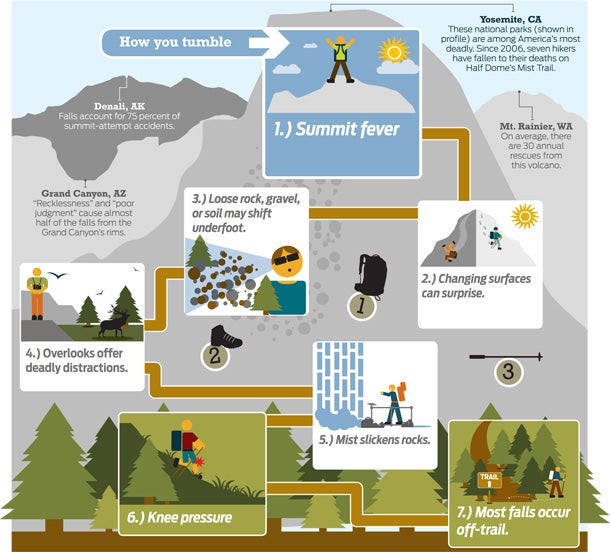Heading out the door? Read this article on the new Outside+ app available now on iOS devices for members! Download the app.
Denali, AK
Falls account for 75 percent of summit-attempt accidents

Grand Canyon, AZ
“Recklessness” and “poor judgment” cause almost half of the falls from the Grand Canyon’s rims.
Yosemite, CA
’s most deadly. Since 2006, seven hikers have fallen to their deaths on Half Dome’s Mist Trail.
Mt. Rainier, WA
On average, there are 30 annual rescues from this volcano.
1.) Summit fever often leads to over-confidence–a common factor in falls. Set multiple goals so options exist if plan A becomes unsafe. Stick to a preset turnaround time.
2.) Changing surfaces can surprise. Shaded slopes may be icier than warmed, sunny ones. Scrutinize snow-covered paths before committing.
3.) Loose rock, gravel, or soil may shift underfoot. Train your eyes on the ground to anticipate rough patches.
4.) Overlooks offer deadly distractions. Stand back from cliff edges and don’t walk while shooting pictures or bearings.
5.) Mist slickens rocks. Use guardrails, stay clear of ledges, and seek handholds.
6.) Knee pressure increases and alertness decreases on descent. Be more cautious as muscle and joint fatigue set in; rest often.
7.) Most falls occur off-trail. Terrain hazards aren’t always obvious. Take care bushwhacking and don’t cut switchbacks.
Gear Tips
1.) Tie gear tightly to your pack, and micro-adjust straps to keep loads close in and improve balance on steeps.
2.) Hiking high? Feet swell at altitude. Adjust laces to make room; tighten upon descent for better step control.
3.) Trekking poles improve balance and reduce fatigue. On downhills, extend poles and plant them firmly. Never brace your full weight on
trekking poles; even serrated tips slip, potentially leading to bad falls.
Slipperiest Surfaces
>> Wet granite Weathered slabs are the worst; wait out the rain if you can. Maximize traction by making contact with the entire sole of your shoe
(or as much of your body as possible).
>> Moss, soaked wood, algae-covered rocks Center your weight, move slowly, and test the slickness and stability of potential steps before committing.
>> Ice Look for the telltale sheen that indicates a hard, slick danger. Cross low-to-high if possible, kicking or carving steps with an axe or trekking
pole tip. Safest bet: Choose low-angle crossings where the consequences of falling are slight.
Which factors contribute most often to mountaineering accidents?
46% Inadequate equipment
21% Insufficient ability
10% Climbing alone
9% Bad weather
8% Equipment failure
6% Other

Pair Up: Lone hikers are more likely to die as a result of a fall.
STOP!
Self-arrest on any terrain.
>> Loose rock Dig in with your heels and crouch to lower your center of gravity.
>> Snow/ice Carry an ice axe in your uphill hand. When falling, flip onto your stomach and push the pick into snow near your head; angle the shaft
across your body. Kick your toes in hard.
>> Smooth slabs The toughest slide to stop–grab for any seam or bush.
Altitude High? Acute mountain sickness (common above 8,000 feet) causes dizziness. If you feel off-balance, sit and rest to prevent a fall.